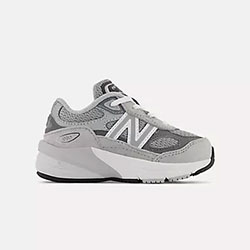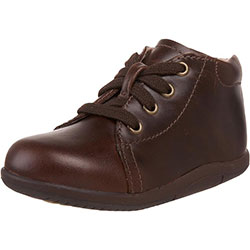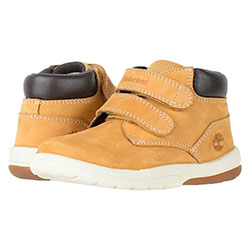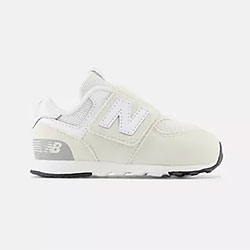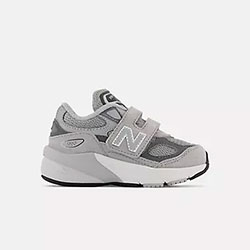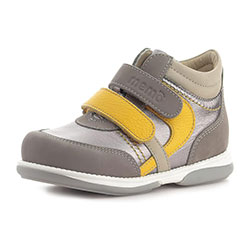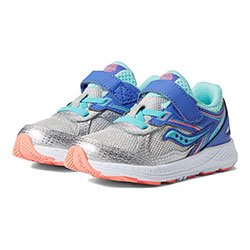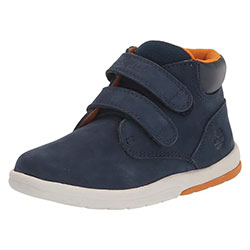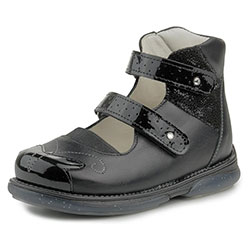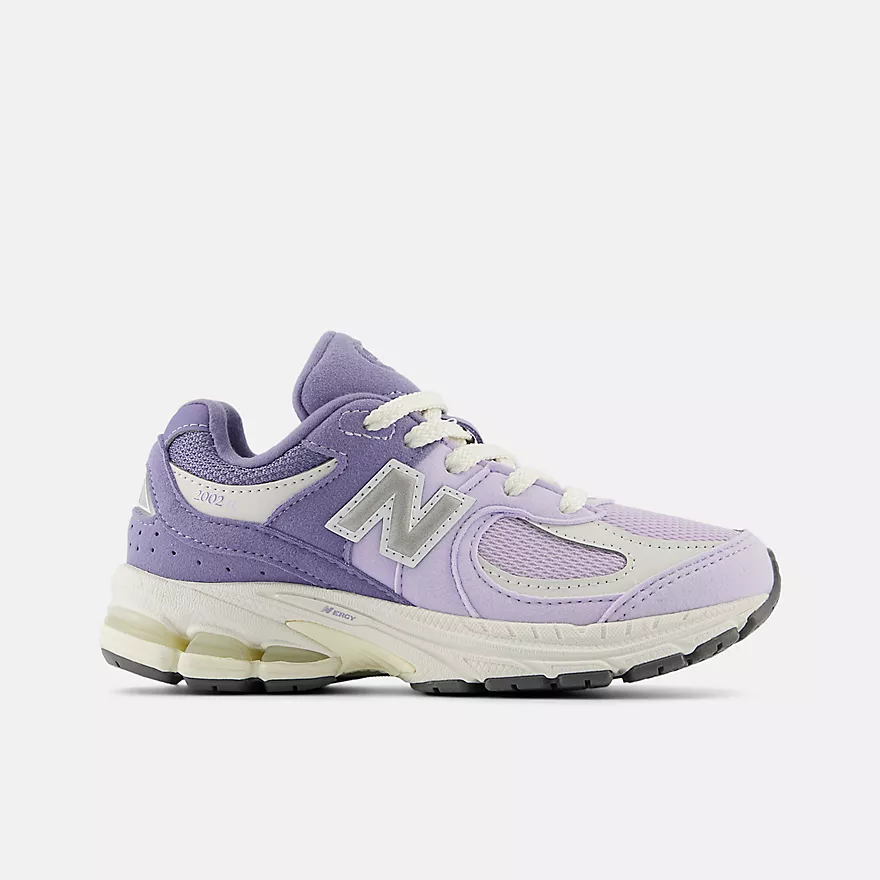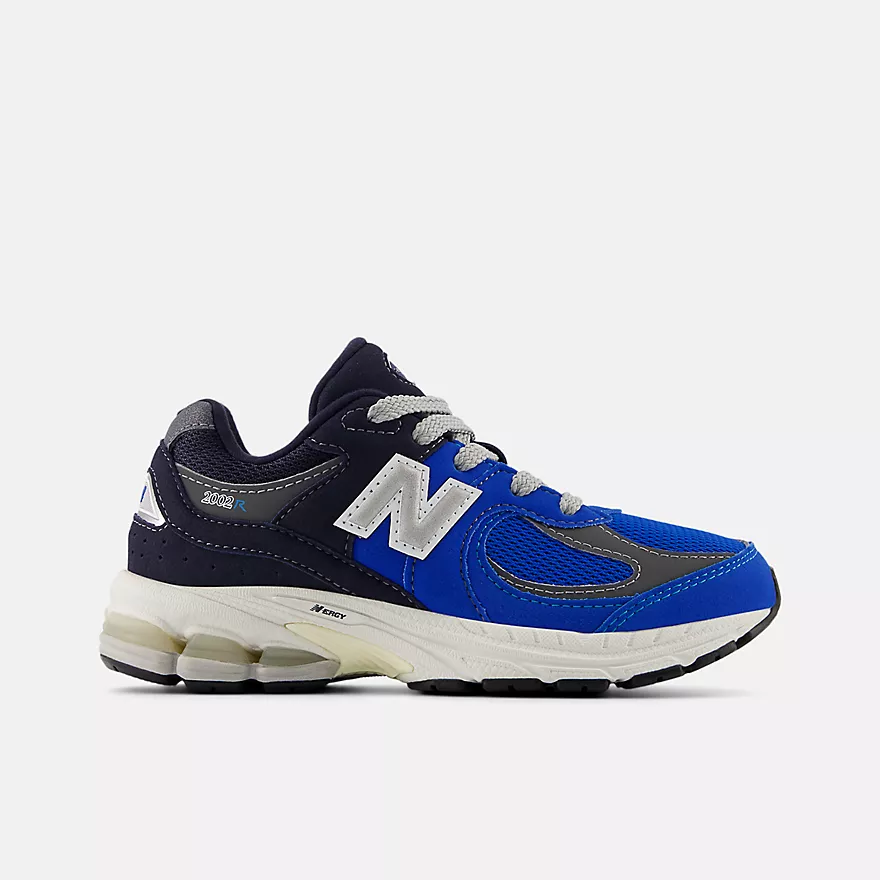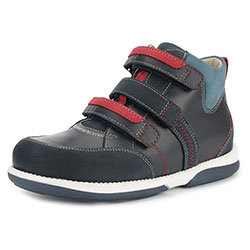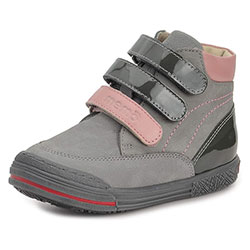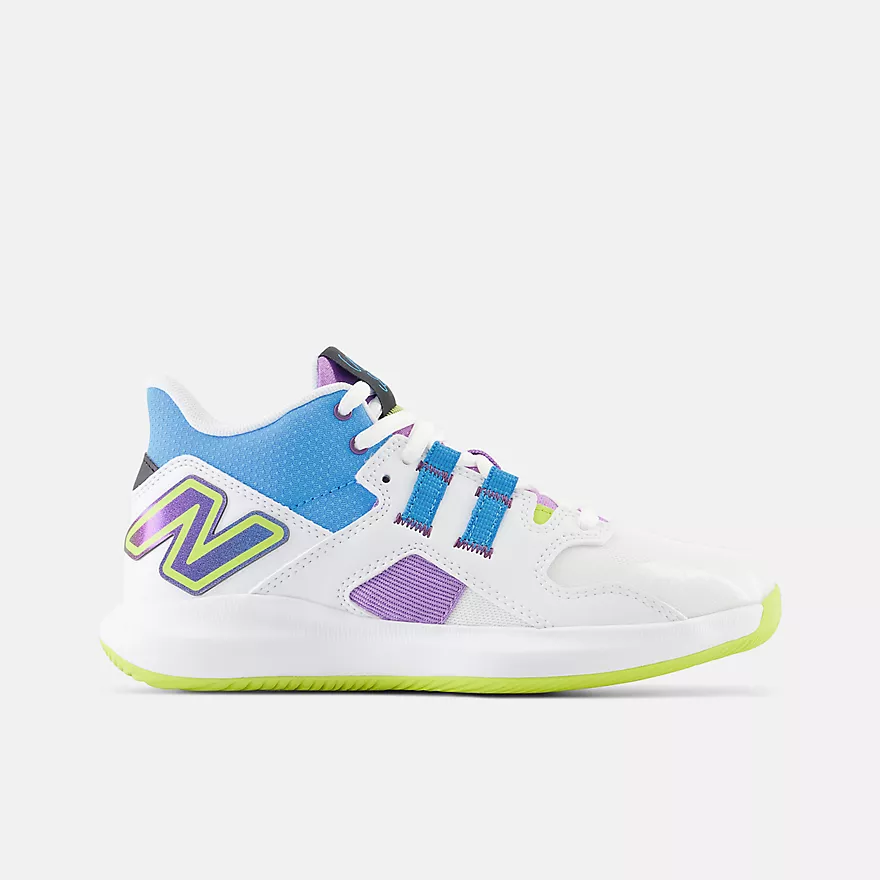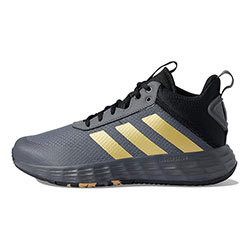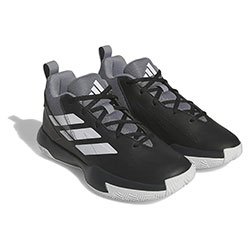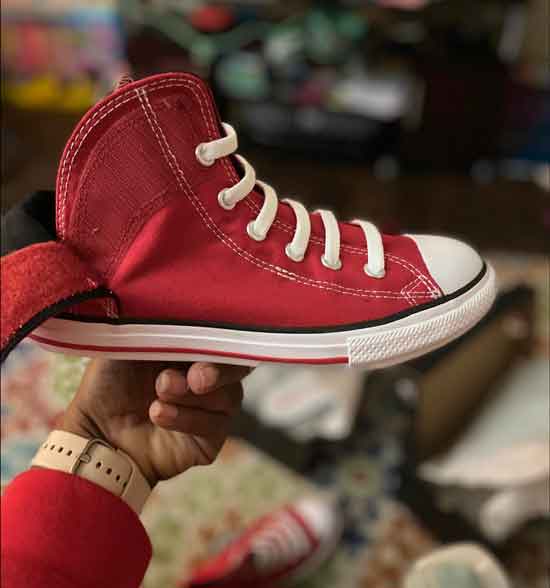Shoes for Kids with Skewfoot – Improve Foot Posture and Stability
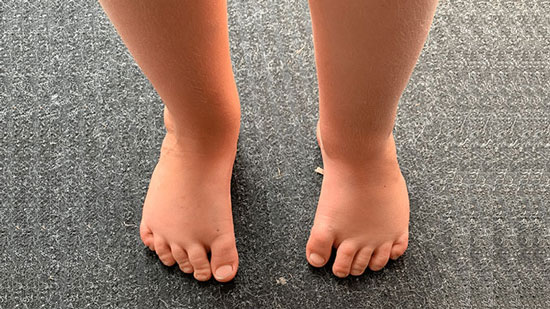
Has your child been diagnosed with skewfoot (also known as serpentine foot) and your medical professional advised you to get supportive shoes to help improve your child’s foot posture and stability? This is a very complex condition, but my goal is to explain it in a simple way. Skewfoot is a condition where the foot appears to have a C-shaped curve; imagine the foot shape somewhat resembling a banana. Supportive shoes specifically designed for this condition can help improve your child’s foot posture, stability, and reduce discomfort during activities.
Most parents are told by their medical professionals to watch for signs such as “collapsed arches” “moderate degrees of pronation” and “turning in of the toes.” It’s important to keep a close eye on your child’s feet to be able to be proactive. Did you know that something so simple such as providing your child with the correct types of shoes can make a world of difference?
My Experience Fitting Children’s Shoes – Over a Decade of Experience
I am not a medical professional, but I can provide expert advice when it comes to children’s footwear. I have been working for a specialized children’s shoe store for over a decade, and we specialize in fitting footwear for children with “complex” foot shapes and conditions. We also specialize in fitting orthotics.
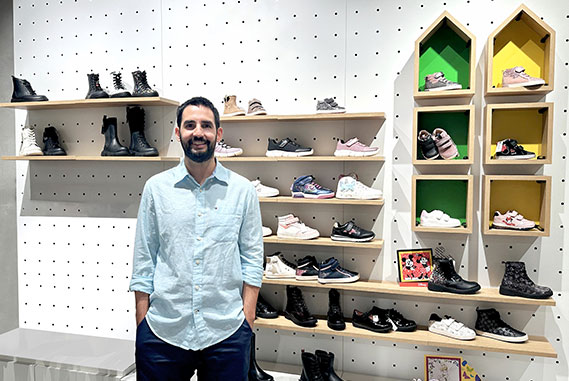
I’ve spoken to several families who’ve seen significant improvements in their kids’ comfort and mobility after switching to the right shoes. The correct types of shoes can impact everything from a child’s posture to their willingness to engage in play and sports.
What Causes Skewfoot? – Is It a Common Condition?
After doing extensive research, I found out that skewfoot refers to a common condition, and most medical professionals believe the positioning of the feet in the womb is what causes it. It’s essential for the doctor to assess the specific cause in each child to determine the appropriate course of action.
How Can This Condition Affect Your Child’s Daily Life?
This condition can influence everything from your child’s balance and coordination to their participation in sports and playtime.
Skewfoot can lead to an uneven distribution of weight across the foot, which affects gait and posture, and might even lead to foot or leg pain. This uneven distribution of weight can cause discomfort, potentially discouraging active play.
There is also a psychological aspect to this condition. Children with noticeable physical differences might refuse to engage socially and physically with others.
How Can Skewfoot Be Corrected?
For mild to moderate cases of skewfoot, supportive shoes and orthotics might be all your child needs. For strong cases of skewfoot, surgery might be needed.
What Makes the Shoes I Recommend Ideal for Skewfoot?
As far as shoes are concerned, we need to look for the following features:
1️⃣ Straight Lasts: You need to stay away from shoes that have an excessively curved last as this can exaggerate the deformity. Shoes with straight lasts can help improve foot posture:

2️⃣ Sturdy heel counter to stabilize the heel and also improve foot posture:

2️⃣ Supportive outsoles to help distribute pressure evenly across the foot:

3️⃣ Flexible soles at the toe area allow for natural movement:
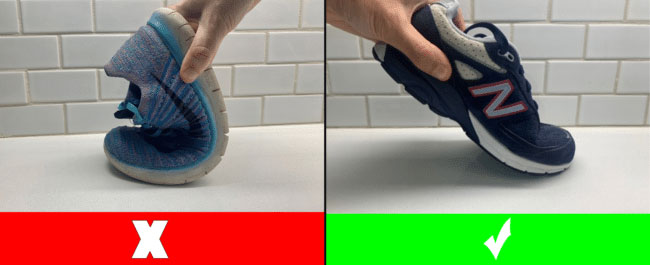
By the way, a comfortable fit prevents additional constraints on the foot structure. Before you order your kids’ shoes online, you must make sure that you know your child’s exact foot length and shape (narrow, medium, wide, extra wide). I can help you determine this in two simple steps.
Shoes for Skewfoot – Effective for Mild to Moderate Cases
How effective the shoes below will be in helping straighten your child’s forefoot and improve your child’s walking gait and overall posture directly depends on how severe the degree of your child’s skewfoot is. Disclosure: Some links in this post may be affiliate links and we may receive a small commission (at no extra cost to you) when you click our links and make purchases.
- The New Balance shoe style 990V6 is available for toddlers, little, and big kids
- Available in laces and velcro
- Fits children with medium, wide, or extra wide feet
- Suede/mesh upper provides durability and breathability
- Order this shoe half a size larger than your toddler’s current foot size
- The New Balance shoe style 990V6 is available for toddlers, little, and big kids
- Available in laces and velcro
- Fits children with medium, wide, or extra wide feet
- Synthetic/mesh upper provides durability and breathability
- Order this shoe half a size larger than your toddler’s current foot size
- The Stride Rite shoe style Elliot is available for toddlers
- Lace-up closure
- Fits toddlers with medium, wide, or extra wide feet
- 100% leather made
- Order this shoe half a size larger than your toddler’s current foot size
- The Stride Rite shoe style Emilia is available for toddlers
- Lace-up closure
- Fits toddlers with medium, wide, or extra wide feet
- 100% leather made
- Order this shoe a whole size larger than your toddler’s current foot size
- The Timberland shoe style Tracks is available for toddlers
- Double velcro straps
- Fits toddlers with medium or wide feet
- Water-friendly
- Order this shoe a whole size larger than your toddler’s current foot size
- The New Balance shoe style 574 is available for toddlers
- Available in velcro and laces
- Fits children with medium, wide, or extra wide feet
- Synthetic/mesh upper provides durability and breathability
- Order this shoe a whole size larger than your toddler’s current foot size
- The New Balance shoe style 990V6 is available for toddlers, little, and big kids
- Available in velcro and laces
- Fits children with medium, wide, or extra wide feet
- Synthetic/mesh upper provides durability and breathability
- Order this shoe a half size larger than your toddler’s current foot size
- The Memo shoe style Gabi is available for toddlers and little kids
- Double velcro straps
- Fits children with medium or wide feet
- Genuine leather and breathable mesh
- Thermoplastic asymmetric stiff heel counter for proper feet protection and stabilization
- Order this shoe half a size larger than your toddler’s current foot size
- The Memo shoe style Gabi is available for toddlers and little kids
- Double velcro straps
- Fits children with medium or wide feet
- Genuine leather and breathable mesh
- Thermoplastic asymmetric stiff heel counter for proper feet protection and stabilization
- Order this shoe half a size larger than your toddler’s current foot size
- The Saucony shoe style Cohesion is available for toddlers
- Velcro closure
- Fits toddlers with medium or wide feet
- Heel grid system for stable cushioning
- Compression molded EVA footbed for comfort
- Order this shoe a whole size larger than your toddler’s current foot size
- The Timberland shoe style Bootie fits toddlers and little kids
- Double velcro straps
- Fits children with medium or wide feet
- Padded collar for a comfortable fit around the ankle
- Water-friendly
- Order this shoe a whole size larger than your toddler’s current foot size
- The Memo shoe style Princessa fits toddlers and little kids
- Double velcro straps
- Fits children with medium or wide feet
- This is an ORTHOPEDIC shoe
- Rigid heel counter
- Order this shoe half a size larger than your toddler’s current foot size
- The Saucony shoe style Cohesion KDZ is available for little and big kids
- Velcro closure
- Fits children with medium and wide feet
- Heel grid system for stable cushioning
- Compression molded EVA footbed for comfort
- Order this shoe a half size larger than your child’s current foot size
- The Saucony shoe style Cohesion KDZ is available for little and big kids
- Velcro closure
- Fits children with medium and wide feet
- Synthetic and mesh upper
- Heel grid system for stable cushioning
- Order this shoe half a size larger than your child’s current foot size
- The New Balance shoe style Fresh Foam 650 is available for little and big kids
- Fits children with medium, wide, or extra wide feet
- Velcro closure
- ABZORB midsole absorbs impact through a combination of cushioning and compression resistance
- Mesh upper material features no-sew overlays for a sleek fit and feel
- Order this shoe half a size larger than your child’s current foot size
- The New Balance shoe style Fresh Foam Arishi v4 is available for little and big kids
- Fits children with medium, wide, or extra wide feet
- Velcro closure
- ABZORB midsole absorbs impact through a combination of cushioning and compression resistance
- Mesh upper material features no-sew overlays for a sleek fit and feel
- Order this shoe half a size larger than your child’s current foot size
- The New Balance shoe style 2002 is available for toddlers and little kids
- Available in laces
- Fits children with medium and wide feet
- Suede/mesh upper provides durability and breathability
- Order this shoe half a size larger than your toddler’s current foot size
- The New Balance shoe style 2002 is available for toddlers and little kids
- Available in laces
- Fits children with medium and wide feet
- Suede/mesh upper provides durability and breathability
- Order this shoe half a size larger than your toddler’s current foot size
- The New Balance shoe style Fresh Foam 650 is available for little and big kids
- Fits children with medium, wide, or extra wide feet
- Velcro closure
- Synthetic and engineered mesh upper
- Fresh Foam midsole cushioning is precision engineered to deliver an ultra-cushioned, lightweight ride
- Order this shoe a half size larger than your child’s current foot size
- The Memo shoe style Polo is available for little and big kids
- Triple velcro straps
- Fits children with medium or wide feet
- This is an orthopedic shoe
- Thermoplastic rigid heel counter
- Order this shoe a half size larger than your child’s current foot size
- The Memo shoe style Chicago is available for little and big kids
- Triple velcro straps
- Fits children with medium or wide feet
- This is an orthopedic shoe
- Thermoplastic rigid heel counter
- Order this shoe a half size larger than your child’s current foot size
- The New Balance shoe style Coco is available for little and big kids
- Lace-up closure
- Fits children with medium or wide feet
- NDurance rubber outsole technology provides superior durability in high-wear areas to help get more out of the shoes
- Order this shoe a half size larger than your child’s current foot size
- The Adidas shoe style Own the Game 2.0 is available for little and big kids
- Lace-up closure
- Fits children with medium or wide feet
- Supportive outsoles and firm heel counter
- Order this shoe a half size larger than your child’s current foot size
- The Adidas shoe style Cross Em Up Select is available for little kids
- Lace-up closure
- Fits children with medium or wide feet
- Non-marking outsole
- Order this shoe a whole larger than your child’s current foot size
- The Saucony shoe style Kinvara LTT is available for little and big kids
- Lace-up closure
- Fits children with medium or wide feet
- Cushioned footbed
- Order this shoe a whole size larger than your child’s current foot size
- The Saucony shoe style Shadow 6000 is available for little and big kids
- Lace-up closure
- Fits children with medium or wide feet
- Cushioned footbed
- Order this shoe half a size larger than your child’s current foot size
- The New Balance shoe style 574 is available for little and big kids
- Lace-up closure
- Fits children with medium or wide feet
- ENCAP midsole cushioning provides good arch and heel support
- Order this shoe half a size larger than your child’s current foot size
- The New Balance shoe style 327 is available for little and big kids
- Lace-up closure
- Fits children with medium or wide feet
- Suede and mesh upper
- Order this shoe a whole size larger than your child’s current foot size
- The New Balance shoe style Fresh Foam X 1080v13 is available for big kids
- Lace-up closure
- Fits children with medium or wide feet
- Suede and mesh upper
- Order this shoe half a size larger than your child’s current foot size
- The New Balance shoe style Fresh Foam X 1080v13 is available for big kids
- Lace-up closure
- Fits children with medium or wide feet
- Suede and mesh upper
- Order this shoe half a size larger than your child’s current foot size
Does Your Child Need Wide Shoes?
This depends on your child’s foot shape. In my experience, most children who are diagnosed with skewfoot have wide feet. If your child happens to have wide feet just make sure that you select the shoes in wide widths, as most of my recommendations above are available in wide and extra wide widths.
Do You Need Orthopedic Shoes to Treat Skewfoot?
Not necessarily. There are two or three of my recommendations that are orthopedic shoes, but most of the shoes I recommended are your regular everyday sneakers that simply provide better support and stability.
The Importance of Being Proactive! – Take Early Action!
Most children get diagnosed with skewfoot when they reach the age between 4 and 6 years old. This condition is difficult to diagnose in young children because the bones are still growing and the exact shape of the foot has not yet been determined until the child is around six years old.
When addressed early, suitable interventions, such as the use of supportive footwear, might not only improve the physical symptoms but also help prevent secondary concerns related to social or psychological effects.
Get in Touch for a Personalized Suggestion
Without a doubt, children’s shoe needs can vary depending on their age, activity level, and specific foot shape (wide, extra wide, high instep) they might have. I am happy to recommend different shoes for your child so don’t hesitate to contact me via email or through the comments section below.
Should You Provide Your Child with a Pair of Orthotics As Well?
if the child reaches the age of four and begins to exhibit severe signs of pain and trouble walking, your doctor may recommend orthotics. The correct types of orthotics paired up with supportive shoes can realign the foot, resulting in favorable long-term outcomes.
With that said, the correct types of shoes and orthotics might not always fix the deformity. Please note that I am an expert when it comes to children’s footwear, but there are other conservative treatments that can be extremely helpful to help treat this condition. Exercises for stretching and physical therapy can be extremely helpful, and surgery should always be left as a last resort.
In my opinion, skewfoot is a complex deformity and no one procedure can address the spectrum of deformities nor can one procedure be applied to all age groups. With that said, something so simple such as providing your child with the correct types of shoes can do wonders for your child’s mobility and self-confidence.
I’ve been loving the feedback from parents who’ve navigated this journey before. They’ve shared invaluable tips such as monitoring the child’s comfort and gait while wearing the new shoes. Let me know in the comments section below if you have any questions or tips you would like to share.
References
“Skewfoot – Orthopedics and Spine Specialists.” Surestep, 2024, https://medicalcitykidsortho.com/skewfoot/

